

Understanding the Distribution of Marine Megafauna in the English Channel Region: Identifying Key Habitats for Conservation within the Busiest Seaway on Earth. The temperate waters of the North-Eastern Atlantic have a long history of maritime resource richness and, as a result, the European Union is endeavouring to maintain regional productivity and biodiversity.
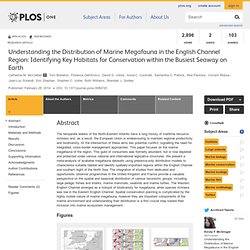
At the intersection of these aims lies potential conflict, signalling the need for integrated, cross-border management approaches. This paper focuses on the marine megafauna of the region. This guild of consumers was formerly abundant, but is now depleted and protected under various national and international legislative structures. Ecological restoration in the deep sea: Desiderata. Open Access Highlights Deep-ocean industries exist and new ones are in development. Restoration can be a component of environmental management in the deep sea. Case studies illustrate motivations for, approaches to, and potential costs of deep-sea restoration.
The science, practice, ethics, and economics of deep-sea restoration need to be developed. Abstract. Global Ocean Commission’s Paul Martin urges a ‘global uprising’ for the global ocean on BBC Radio’s ‘Shared Planet’ programme. Global Ocean Commission’s Paul Martin urges a ‘global uprising’ for the global ocean on BBC Radio’s ‘Shared Planet’ programme.
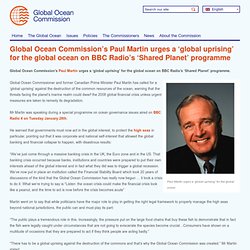
Government must do more to protect biodiversity in Overseas Territories. Environmental Audit Committee Chair, Joan Walley MP: “The natural environment in the Overseas Territories is incredibly diverse, but it is currently under-protected.

That is ultimately a UK Government responsibility. The UK Government doesn’t even know precisely what it is responsible for, because it has failed accurately to assess and catalogue those species and habitats.” Tiny Pacific island nations create world's largest marine parks. Two of the world's smallest countries are to place nearly 2.5 million square kilometres of south Pacific Ocean in newly created marine protected areas.
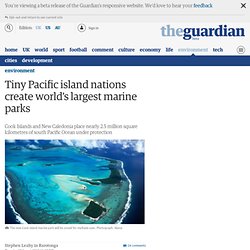
The Cook Islands, nation of 20,000 people on 15 islands, formally announced on Tuesday the creation of the world's largest marine park covering nearly 1.1m sq km, an area bigger than France and Germany. "This is our contribution not only to our own wellbeing but also to humanity's wellbeing," said the prime minister, Henry Puna. UK sets up Chagos Islands marine reserve. John Kerry calls for expansion of world's marine reserves. US secretary of state John Kerry called for expanding the world’s marine reserves by a factor of 10 on Tuesday, signalling a bolder new US approach to international environmental protection.
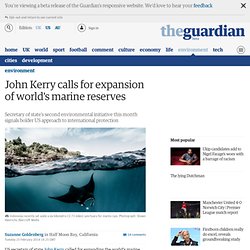
In his second environmental initiative this month, Kerry called for greater global co-operation in managing fishing stocks and protecting oceans from pollution and climate change. He said the State Department would convene a two-day summit in the summer intended to build momentum for greater co-operation on managing the world’s oceans.
“Think of the progress we can make if just 10% of marine areas were protected,” Kerry said in a video address to a high-level oceans meeting hosted by the Economist and National Geographic. “I think that is a goal we should set for ourselves.” Environment ministers from almost 200 countries signed on to a United Nations strategy to widen marine protection zones to 10% of oceans at a meeting in Japan four years ago. Interactive Map: The Changing Arctic. Man and the Last Great Wilderness: Human Impact on the Deep Sea. Results and Discussion Disposal of litter and waste The deep seafloor is, for most people, out of sight and therefore, often, out of mind.
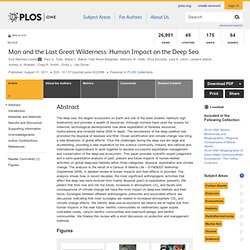
This has encouraged, for centuries, the dumping of waste of all sorts into deep waters, with (largely) unknown and un-studied effects on the habitats and their fauna. Man and the Last Great Wilderness: Human Impact on the Deep Sea. Charles Moore: Seas of plastic. Man and the Last Great Wilderness: Human Impact on the Deep Sea. Still-fresh remnants of Exxon Valdez oil 25 years after oil spill, found protected by boulders. Disposal At Sea. March 30, 2009 Issue - Vol. 87 Issue 13. Scene 1: Water Sample Collection Researchers use robotic arms to collect water samples near munitions located off Pearl Harbor.
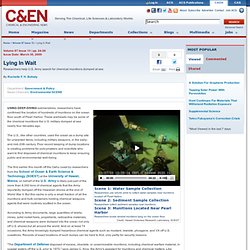
Scene 2: Sediment Sample Collection Researchers collect sediment samples near munitions. Disposal At Sea. Www.fas.org/sgp/crs/misc/RL32344. Archaeal dominance in the mesopelagic zone of the Pacific Ocean : Abstract : Nature. Pone.0029232 1..12 - fetchObject.action. Pone.0061550 1..10 - fetchObject.action. Venture Deep Ocean [ Volcanoes & Vents ] Hydrothermal vents: underwater geysers What happens when tectonic plates move towards each other: subduction, trenches and mountain building.
![Venture Deep Ocean [ Volcanoes & Vents ]](http://cdn.pearltrees.com/s/pic/th/venture-ocean-volcanoes-vents-77519940)
Hot fluid jets and wafts from cracks in the seafloor thousands of meters below the ocean surface. The fluid is essentially water that has filtered down into the rock of the Earth's crust through tiny channels and fissures. Surrounding rocks heat the water as it moves downwards, and various minerals dissolve in it. Vents occur where some of the hot fluid finds its way back to the surface. Deepest undersea vents discovered by UK team. 21 February 2013Last updated at 02:53 ET By David Shukman Science editor, BBC News David Shukman joins researchers examining the sea bed UK scientists exploring the ocean floor in the Caribbean have discovered an "astounding" set of hydrothermal vents, the deepest anywhere in the world.

Deploying a remotely-operated vehicle (ROV) in the Cayman Trough, they stumbled across a previously-unknown site nearly 5000m below the surface. Video pictures relayed live back to the research ship mounting the operation show spindly chimneys up to 10m high. The muddy deep-sea bed is not a desert. On my first ever trip to sea in 1999 on the scientific research ship ‘Challenger’ we were investigating an area of the Irish deep sea known as the Porcupine Seabight at about 1300m, as part of a long term research programme monitoring the animals that live on the seabed.
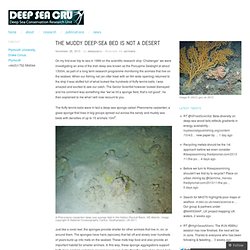
When our fishing net (an otter trawl with an 8m wide opening) returned to the ship it was stuffed full of what looked like hundreds of fluffy tennis balls. I was amazed and excited to see our catch. The Senior Scientist however looked dismayed and his comment was something like “we’ve hit a sponge field, that’s not good”, he then explained to me what I will now recount to you. The fluffy tennis balls were in fact a deep-sea sponge called Pheronema carpenteri, a glass sponge that lives in big groups spread out across the sandy and muddy sea beds with densities of up to 15 animals 10m2. National Oceanography Centre, Southampton - PAP. Autosub surveys deep ocean floor off Land's End.
1 August 2012Last updated at 12:15 ET By Jonathan Amos Science correspondent, BBC News A sample image shows a dumbo octopus (25cm diameter) at top left. Subsea World News - Gorringe Seamounts to Become New Marine Protected Area. At 5000 m high, the Gorringe seamounts, located in the Atlantic, 300 km off the Portuguese shore, are on their way to becoming a new Marine Protected Area, following their nomination by the Portuguese government. Oceana, which has documented this area on several occasions, is thrilled with this announcement. Ocean trench: Take a dive 11,000m down. Bg-7-2851-2010.pdf. Mystery of bottle gourd migration to Americas solved. Radiation in Japan Seas: Risk of Animal Death, Mutation?
If radioactive material from the Fukushima Daiichi nuclear power plant—disabled by the March11 Japan earthquake and tsunami—continues to enter the ocean, marine life could be threatened, experts say. (See related photos: "Japan Tsunami: 20 Unforgettable Pictures. ") In the past week, seawater samples taken near the nuclear power plant, on Japan's eastern coast, have shown elevated levels of radioactive isotopes, including cesium 137 and iodine 131, according to the New York Times. (See "Japan Tries to Avert Nuclear Disaster. ") All life on Earth and in the oceans lives with exposure to natural levels of ionizing radiation—high-frequency radiation with enough energy to change DNA. Fukushima. Birds Korea: Spoon-billed Sandpiper Conservation – a Korean and Yellow Sea Perspective. Institution d'Aménagement de la Vilaine.